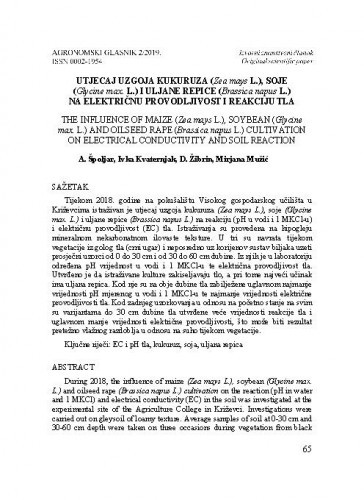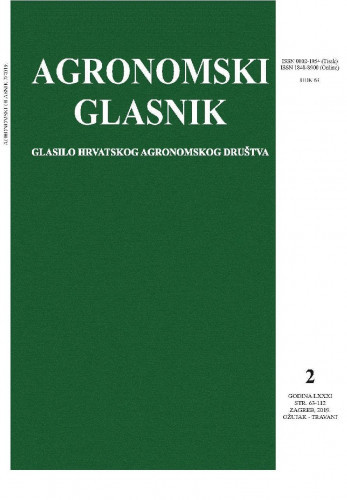Tijekom 2018. godine na pokušalištu Visokog gospodarskog učilišta u Križevcima istraživan je utjecaj uzgoja kukuruza (Zea mays L.), soje (Glycine max. L.) i uljane repice (Brassica napus L.) na reakciju (pH u vodi i 1 MKCl-u) i električnu provodljivost (EC) tla. Istraživanja su provedena na hipogleju mineralnom nekarbonatnom ilovaste teksture. U tri su navrata tijekom vegetacije iz golog tla (crni ugar) i neposredno uz korijenov sustav biljaka uzeti prosječni uzorci od 0 do 30 cm i od 30 do 60 cm dubine. Iz njih je u laboratoriju određena pH vrijednost u vodi i 1 MKCl-u te električna provodljivost tla. Utvrđeno je da istraživane kulture zakiseljavaju tlo, a pri tome najveći učinak ima uljana repica. Kod nje su na obje dubine tla zabilježene uglavnom najmanje vrijednosti pH mjerenog u vodi i 1 MKCl-u te najmanje vrijednosti električne provodljivosti tla. Kod zadnjeg uzorkovanja u odnosu na početno stanje na svim su varijantama do 30 cm dubine tla utvrđene veće vrijednosti reakcije tla i uglavnom manje vrijednosti električne provodljivosti, što može biti rezultat pretežno vlažnog razdoblja u odnosu na suho tijekom vegetacije.; During 2018, the influence of maize (Zea mays L.), soybean (Glycine max.L.) and oilseed rape (Brassica napus L.) cultivation on the reaction (pH in water and 1 MKCl) and electrical conductivity (EC) in the soil was investigated at the experimental site of the Agriculture College in Križevci. Investigations were carried out on gleysoil of loamy texture. Average samples of soil at 0-30 cm and 30-60 cm depth were taken on three occasions during vegetation from black fallow and in close vicinity of the plant root system. In them, the pH value in the water and 1 MKCl and the electrical conductivity in the soil were determined. It has been found that the studied crops acidify the soil, and the biggest effect is of oilseed rape. The lowest values of pH measured in water and 1 MKCl and the lowest value of electrical conductivity of the soil were recorded for oilseed rape at both depths of the soil. At the end of the study, in all variants at 0-30 cm depth, generally higher values of soil reaction and mainly lower values of electrical conductivity were found, compared to the beginning of the research. The mentioned could be the result of a mostly humid period relative to dry period during vegetation.
Utjecaj uzgoja kukuruza (Zea mays L.), soje (Glycine max. L.) i uljane repice (Brassica napus L.) na električnu provodljivost i reakciju tla = The influence of maize (Zea mays L.), soybean, (Glycine max. L.) and oilseed rape (Brassica napus L.) cultivation on electrical conductivity and soil reaction / Andrija Špoljar, Ivka Kvaternjak, Drago Žibrin, Mužić Mirjana.
Sažetak

 Agronomski glasnik : glasilo Hrvatskog agronomskog društva : 81,2(2019) / glavni i odgovorni urednik, editor-in-chief Ivo Miljković.
Agronomski glasnik : glasilo Hrvatskog agronomskog društva : 81,2(2019) / glavni i odgovorni urednik, editor-in-chief Ivo Miljković.